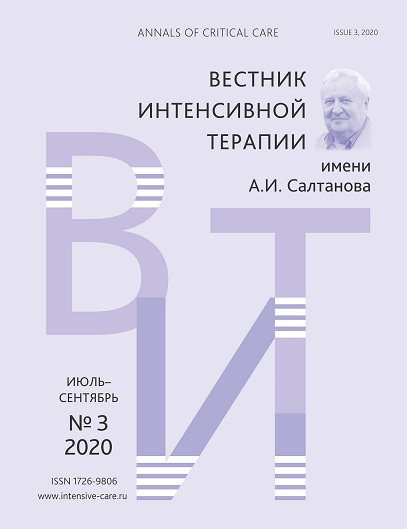Аннотация
Введение. Распространенность нозокомиальных инфекций в стационарах Москвы составляет 7,61 %. В условиях практически тотальной поли- и панрезистентности возбудителей нозокомиальной пневмонии (НП) в отделениях реанимации поиск альтернативных методов антибиотикотерапии является актуальным. Одна из таких альтернатив — ингаляционные антибиотики (ИА). В данной публикации приведены результаты исследования «Ингаляционные антибиотики в реаниматологии» на основе анкетного опроса врачей — анестезиологов-реаниматологов.
Цель исследования. Анализ частоты применения ингаляционных форм антибиотиков при НП у реаниматологических пациентов в стационарах Российской Федерации.
Материалы и методы. Данный опрос был рецензирован двумя ведущими профильными специалистами, утвержден 25.11.2017 комитетом по рекомендациям и организации исследований Федерации анестезиологов и реаниматологов (ФАР) России (http://www.far.org.ru/research/362-ingabx). Опрос проводился 10.01.2018–30.10.2018.
Результаты. По результатам исследования были получены данные о распространенности использования ИА для лечения НП (64 % опрошенных); показаниях (все опрошенные используют отечественные рекомендации; 80 % назначает ИА при неэффективности текущего режима антибиотикотерапии); используемых лекарственных препаратах (колистиметат натрия применяется в 52 % случаев (11 респондентов), тобрамицин — 9 % (2 респондента), амикацин — 24 % (5 респондентов), другое (ацетилцистеин-антибиотик, гентамицин, цефалоспорины различных поколений, бактериофаги) — 15 % (3 респондента)) и оборудовании (более 90 % используют небулайзеры с вибрирующей пластиной), критериях их отмены (крайне разрозненные ответы).
Выводы. Результаты анкетирования позволяют обосновать целесообразность дополнительных рандомизированных контролируемых исследований по данной проблеме.
Библиографические ссылки
- Яковлев С.В., Суворова М.П., Белобородов В.Б. и др. Распространенность и клиническое значение нозокомиальных инфекций в лечебных учреждениях России: исследование ЭРГИНИ. Антибиотики и химиотерапия. 2016; 61(5, 6): 32–42. [Jakovlev S.V., Suvorova M.P., Beloborodov V.B., et al. Rasprostranennost’ i klinicheskoe znachenie nozokomial’nyh infekcij v lechebnyh uchrezhdenijah Rossii: issledovanie JeRGINI. Antibiotiki i himioterapija. 2016; 61(5, 6): 32–42. (In Russ)]
- Гельфанд Б.Р. Нозокомиальная пневмония у взрослых. Российские национальные рекомендации. М.: МИА, 2016. 176 с. [Gelfand B.R. Nozokomial’naya pnevmoniya u vzroslyh. Rossijskie nacional’nye rekomendacii. М.: MIA, 2016. 176 с. (In Russ)]
- Кузовлев А.Н., Шабанов А.К., Гречко А.В. Нозокомиальный трахебронхит в реаниматологии: проблемы диагностики и лечения. Вестник интенсивной терапии имени А.И. Салтанова. 2018; 1: 43–47. DOI: 10.21320/1818-474X-2019-2-40-47 [Kuzovlev A.N., Shabanov A.K., Grechko A.V. Nozokomial’nyj trahebronhit v reanimatologii: problemy diagnostiki i lechenija. Annals of Intensive Care. 2018; 1: 43–47. (In Russ)]
- Torres A., Niederman M.S., Chastre J., et al. International ERS/ESICM/ESCMID/ALAT guidelines for the management of hospital-acquired pneumonia and ventilator-associated pneumonia: Guidelines for the management of hospital-acquired pneumonia (HAP)/ventilator-associated pneumonia (VAP) of the European Respiratory Society (ERS), European Society of Intensive Care Medicine (ESICM), European Society of Clinical Microbiology and Infectious Diseases (ESCMID) and Asociación Latinoamericana del Tórax (ALAT). Eur. Respir. J. 2017; 50(3): 1700582. DOI: 10.1183/13993003.00582-2017
- Kalil A.C., Metersky M.L., Klompas M., et al. Management of Adults With Hospital-acquired and Ventilator-associated Pneumonia: 2016 Clinical Practice Guidelines by the Infectious Diseases Society of America and the American Thoracic Society. Clin. Infect. Dis. 2016; 63(5): e61–e111. DOI: 10.1093/cid/ciw353
- Spellberg В. The future of antibiotics. Critical Care. 2014; 18(3): 228. DOI: 10.1186/cc13948
- Амелина Е.Л., Чучалин А.Г. Ингаляционный тобрамицин в лечении синегнойной инфекции у больных муковисцидозом. Пульмонология. 2009; 5: 120–126. [Amelina E.L., Chuchalin A.G. Ingaljacionnyj tobramicin v lechenii sinegnojnoj infekcii u bol’nyh mukoviscidozom. Pul’monologija. 2009; 5: 120–126. (In Russ)]
- Rello J., Solé-Lleonart C., Rouby J., et al. Use of Nebulized Antimicrobials for the Treatment of Respiratory Infections in Invasively Mechanically Ventilated Adults: A Position Paper from the European Society of Clinical Microbiology and Infectious Diseases. Clin. Microbiol. Infect. 2017; Apr 13; pii: S1198-743X(17)30219-7. DOI: 10.1016/j.cmi.2017.04.011.
- Montgomery A., Rhomberg P., Abuan T., et al. Potentiation effects of amikacin and fosfomycin against selected amikacin-nonsusceptible Gram-negative respiratory tract pathogens. Antimicrob Agents Chemother. 2014; 58: 3714–9. DOI: 10.1128/AAC.02780-13
- Montgomery A., Vallance S., Abuan T., et al. A randomized double-blind placebo-controlled dose-escalation Phase 1 study of aerosolized amikacin and fosfomycin delivered via the PARI Investigational eFlow® Inline Nebulizer System in mechanically ventilated patients. J. Aerosol. Med. Pulm. Drug Deliv. 2014; 27: 441–8. DOI: 10.1089/jamp.2013.1100
- Hallal A., Cohn S., Namias N., et al. Aerosolized tobramycin in the treatment of ventilator associated pneumonia: a pilot study. Surg. Infect. (Larchmt). 2007; 8: 73–81.
- Bassetti M., Vena A., Russo A., Peghin M. Inhaled Liposomal Antimicrobial Delivery in Lung Infections [published online ahead of print, 2020 Jul 20]. Drugs. 2020. DOI: 10.1007/s40265-020-01359-z
- Кузовлев А.Н., Шабанов А.К., Тюрин И.А. Динамика концентрации ингаляционного тобрамицина в крови и бронхоальвеолярной лаважной жидкости при нозокомиальной пневмонии (предварительное сообщение). Общая реаниматология. 2018; 14(5): 32–37. DOI: 10.15360/1813-9779-2018-5-32-37 [Kuzovlev A.N., Shabanov A.K., Tyurin I.A. Dinamika koncentracii ingalyacionnogo tobramicina v krovi i bronhoal’veolyarnoj lavazhnoj zhidkosti pri nozokomial’noj pnevmonii (predvaritel’noe soobshchenie). Obshchaya reanimatologiya. 2018; 14(5): 32–37. (In Russ)]
- Кузовлев А.Н., Гречко А.В. Ингаляционные антибиотики в реаниматологии: состояние, проблемы и перспективы развития. Общая реаниматология. 2017; 13(5): 69–84. DOI: 10.15360/1813-9779-2017-5-69 [Kuzovlev A.N., Grechko A.V. Ingaljacionnye antibiotiki v reanimatologii: sostojanie, problemy i perspektivy razvitija. Obshhaja reanimatologija. 2017; 13(5): 69–84. (In Russ)]
- Ярошецкий А.И., Резепов Н.А., Мандель И.А. и др. Влияние ингаляции амикацина на эффективность лечения вентилятор-ассоциированной пневмонии и вентилятор-ассоциированного трахеобронхита, вызванных полирезистентной грамотрицательной флорой. Сравнительное исследование. Анестезиология и реаниматология. 2018; 63(1): 61–68. DOI: 10.18821/0201-7563-2018-63-1-61-68 [Yaroshetskiy A.I., Rezepov N.A., Mandel I.A., et al. The effect of amikacin inhalation on the effectiveness of the treatment of ventilator-associated pneumonia and ventilator-associated tracheobronchitis caused by multiple drug resistant gram-negative flora. A comparative study. Anesteziologija i reanimatologija. 2018; 63(1): 61–68. (In Russ)]


